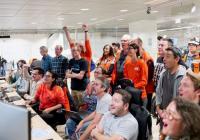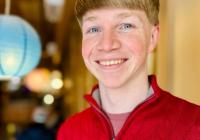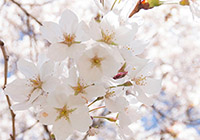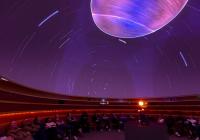Spring 2025
Dear Astronomy Community,
There are moments in our field when years of collective effort culminate in something truly extraordinary. On April 15, 2025, our department witnessed such a moment when the first on-sky engineering data from the Simonyi Telescope's LSSTCam was displayed. If you haven't already, please take a look at the photo accompanying this newsletter – those expressions of joy and wonder tell the story better than any words can.

Jessica Werk: Professor and Chair of Astronomy
I can't help but feel both elated and worried as I look at those beaming faces. We've achieved something remarkable, yet at the same time, we're hearing about proposed budget cuts that threaten to slash science funding in the United States by nearly 50%. These proposals would impact missions that represent decades of planning, billions in investment, and the dreams of countless scientists.
Looking at that team photo from Rubin nevertheless gives me hope. Our field has never had it easy. We keep going because curiosity is woven into our being. We keep going because every time we make a new discovery, people lean in and pay attention. When that first image from LSST appeared, you could see on everyone's faces exactly why astronomy endures.
And nowhere is that enduring spirit more evident than in our students. Our department's graduation ceremony on Friday, June 13th will celebrate our graduating bachelor's, master's, and Ph.D. students alongside family, friends, and our entire Astronomy community. Their achievements represent our future, and what a bright future it is! Please join us in celebrating our incredible UW Astronomy students – some of whom are featured in this newsletter.
When I get discouraged about budget proposals, I remind myself why we're all here in the first place. It's definitely not the money - it's those moments when we glimpse something no one has ever seen before. That shared excitement is what makes us a community, not organizational charts or funding lines.
The stars will continue to shine, and so will we.
Supporting our UW Astronomy Community
The strength of UW Astronomy lies in our extended network of supporters, alumni, and friends who share our vision of mutual support in astronomical research and education. Our community building events, student support initiatives, and efforts to make astronomy more accessible require sustained commitment - both in energy and resources. As we face unprecedented challenges to scientific institutions, building robust networks of support becomes even more critical.
You can help ensure the continuation of our vital community programs by contributing to our featured funds on this page. Your support enables us to host events that bring our community together, provide opportunities for students from all backgrounds, and maintain the strong departmental culture that makes UW Astronomy a leader in both scientific excellence and institutional change.
Together, we can ensure that the next generation of astronomers has the resources and support they need to unlock the mysteries of our Universe - from mapping the cosmic web to discovering potentially habitable worlds among the stars.
Additional Community Resources
Food Pantry
The UW Food Pantry provides free food and hygiene products to any UW student, staff, or faculty member in need. They accept donations of shelf-stable items and hygiene products from individuals at their Poplar Hall location during opening hours.
Know Your Rights
Understanding your rights is essential for all community members. These resources provide comprehensive information about individual rights, campus policies, and legal protections.
UW Public Safety Office - Know Your Rights
ACLU Washington - Know Your Rights
Diversity and Inclusion Resources
Resources to support diversity and inclusion efforts in astronomy and STEM fields:
- TEAM-UP Report - Comprehensive report addressing systemic barriers for underrepresented minorities in physics and astronomy
- Black Lives in Astronomy Resource Guide - Extensive resource guide on Black astronomers ranging from blogs and feature articles to historical information
- Astrobites: How to Support Black Astronomers - Practical guidance for supporting Black astronomers in academic and professional settings
- AAS Task Force Report on Diversity and Inclusion (2018) - Recommendations and findings on improving diversity and inclusion in astronomy
Educational Resources
- UW Center for Teaching, Learning, and Mentoring - Professional development workshops, teaching resources, and pedagogical training opportunities
- Leadership Without Borders Undocu Ally Training – This program provides UW faculty and staff with resources and best practices to build a supportive environment for undocumented students.




